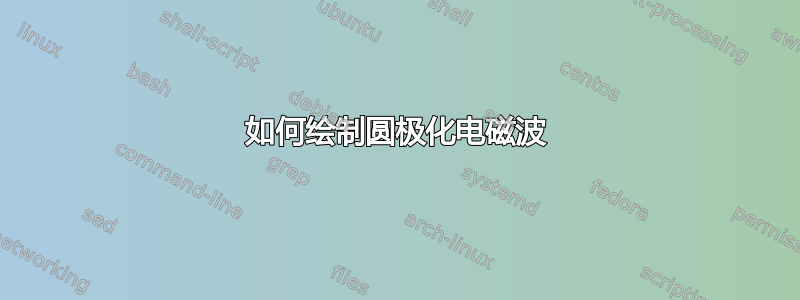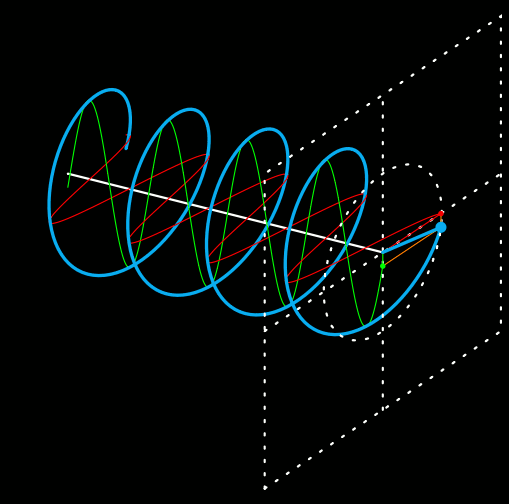
我正在寻找一种解决方案,以便在我的乳胶文档中获得美观的圆偏振波。我的目标是得到一个如下所示的图表:

我不希望图表有动画,但我甚至无法让它绘制圆形波浪。
任何帮助都将非常感激。
答案1
可能是这样的吗?不确定是否正确。
\documentclass{standalone}
\usepackage{tikz}
\begin{document}
\begin{tikzpicture}[x={(0.75cm,.5cm)}, z={(1cm,-.25cm)}]
\tikzset{%
xyz path/.style args={\x=#1; \y=#2; \z=#3; (#4)}{
insert path={
\foreach \step [evaluate={\x=#1; \y=#2; \z=#3;}] in {#4}{
-- (\x, \y, \z) }
}
},
cosine path/.style args={#1:#2}{
xyz path={\x=cos(\step); \y=0; \z=\step/360; (#1, 5, ..., #2)},
insert path={ coordinate (cosine path end) }
},
sine path/.style args={#1:#2}{
xyz path={\x=0; \y=sin(\step); \z=\step/360; (#1, 5, ..., #2)},
insert path={ coordinate (sine path end) }
},
spiral path/.style args={#1:#2}{
xyz path={\x=cos(\step); \y=sin(\step); \z=\step/360; (#1, 5, ..., #2)},
insert path={ coordinate (spiral path end) }
},
marker/.style={
insert path={
node [fill, circle, inner sep=0pt, minimum size=#1] {}
}
}
}
\def\lastangle{135}
\def\cycles{5}
\foreach \cycle in {0,...,\cycles}{
\tikzset{shift={(0, 0, \cycle)}}
\ifnum\cycle=\cycles
\let\endangle=\lastangle
\else
\def\endangle{360}
\fi
\draw [red] (1, 0, 0) [cosine path={0:\endangle}];
\draw [green] (0, 0, 0) [sine path={0:\endangle}];
\draw [blue, very thick] (1, 0, 0) [spiral path={0:\endangle}];
}
\tikzset{shift={(0,0,\cycles+\lastangle/360)}}
\draw [dotted, thick]
(-2,-2, 0) -- (2,-2,0) -- (2,2,0) -- (-2,2,0) -- cycle
(0,-2) -- (0,2) (-2,0) -- (2,0)
(1, 0)
\foreach \step [evaluate={\y=sin(\step); \x=cos(\step);}] in {0, 5, ..., 355}{
-- (\x, \y, 0) } ;
\draw [orange] (cosine path end) -- (spiral path end) -- (sine path end);
\draw [red] (0,0,0) -- (cosine path end) [marker=2pt];
\draw [green] (0,0,0) -- (sine path end) [marker=2pt];
\draw [blue, very thick] (0,0,0) -- (spiral path end) [marker=4pt];
\end{tikzpicture}
\end{document}

编辑当然我们可以做得更好:
\documentclass{standalone}
\usepackage[active,tightpage]{preview}
\usepackage{tikz}
\PreviewEnvironment{tikzpicture}
\usetikzlibrary{backgrounds}
\begin{document}
\tikzset{%
calculate step/.code=\pgfmathsetmacro\step{#1+5},
cosine path/.style args={#1:#2}{
insert path={ [calculate step=#1]
(cos #1, 0, #1/360)
\foreach \t in {#1, \step, ..., #2}{ -- (cos \t, 0, \t/360) }
coordinate (cosine path end)
}
},
sine path/.style args={#1:#2}{
insert path={ [calculate step=#1]
(0, sin #1, #1/360)
\foreach \t in {#1, \step, ..., #2}{ -- (0, sin \t, \t/360) }
coordinate (sine path end)
}
},
spiral path/.style args={#1:#2}{
insert path={ [calculate step=#1]
(cos #1, sin #1, #1/360)
\foreach \t in {#1,\step, ..., #2}{ -- (cos \t, sin \t, \t/360) }
coordinate (spiral path end)
},
},
marker/.style={
insert path={
node [fill, circle, inner sep=0pt, minimum size=#1] {}
}
},
background/.style={
background rectangle/.style={fill=black},
show background rectangle
},
cosine/.style={
red
},
sine/.style={
green
},
spiral/.style={
cyan,
very thick
},
indicator/.style={
orange
},
grid/.style={
white,
loosely dotted,
thick
},
axis/.style={
white,
thick
}
}
\def\cycles{4}
\foreach \phase in {0, 10, ..., 350}{%
\begin{tikzpicture}[x={(0.75cm, .5cm)}, z={(1cm, -.25cm)},
background,
line cap=round
]
\draw [axis] (0, 0, \phase/360) -- (0, 0, \cycles+\phase/360);
\foreach \cycle in {0,...,\cycles}{
\tikzset{shift={(0, 0, \cycle)}}
\ifnum\cycle=0
\let\startangle=\phase
\else
\def\startangle{0}
\fi
\ifnum\cycle=\cycles
\let\endangle=\phase
\else
\def\endangle{360}
\fi
\draw [cosine] [cosine path={\startangle:\endangle}];
\draw [sine] [sine path={\startangle:\endangle}];
\draw [spiral] [spiral path={\startangle:\endangle}];
}
\begin{scope}[shift={(0, 0, \cycles+\phase/360)}]
\draw [grid]
(-2, -2, 0) -- (2, -2, 0) -- (2, 2, 0) -- (-2, 2, 0) -- cycle
(0, -2) -- (0, 2) (-2, 0) -- (2, 0)
(1, 0) \foreach \t in {0, 5, ..., 355}{ -- (cos \t, sin \t, 0) };
\draw [indicator] (cosine path end) -- (spiral path end) -- (sine path end);
\draw [cosine] (0, 0, 0) -- (cosine path end) [marker=2pt];
\draw [sine] (0, 0, 0) -- (sine path end) [marker=2pt];
\draw [spiral] (0, 0, 0) -- (spiral path end) [marker=4pt];
\end{scope}
\useasboundingbox
[shift={(0, 0, \phase/360)}]
(-1.125, -1.125, 0) -- (1.125, -1.125, 0) --
(1.125, 1.125, 0) -- (-1.125, 1.125, 0) -- cycle
[shift={(0, 0, \cycles)}]
(-2.125, -2.125, 0) -- (2.125, -2.125,0) --
(2.125, 2.125, 0) -- (-2.125, 2.125, 0) -- cycle;
\end{tikzpicture}}
\end{document}

请注意,在上面的代码生成的 PDF 中,螺旋是向后旋转的,因此当 Gimp 生成动画时,它会朝另一个方向旋转。


